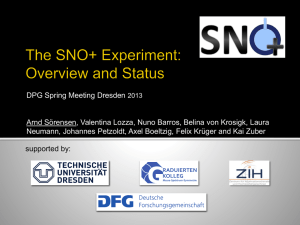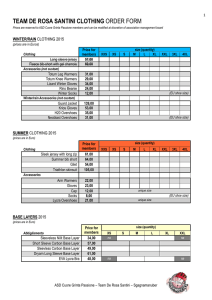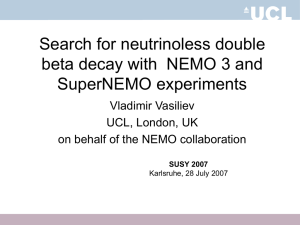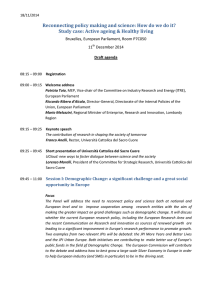100 kg
advertisement
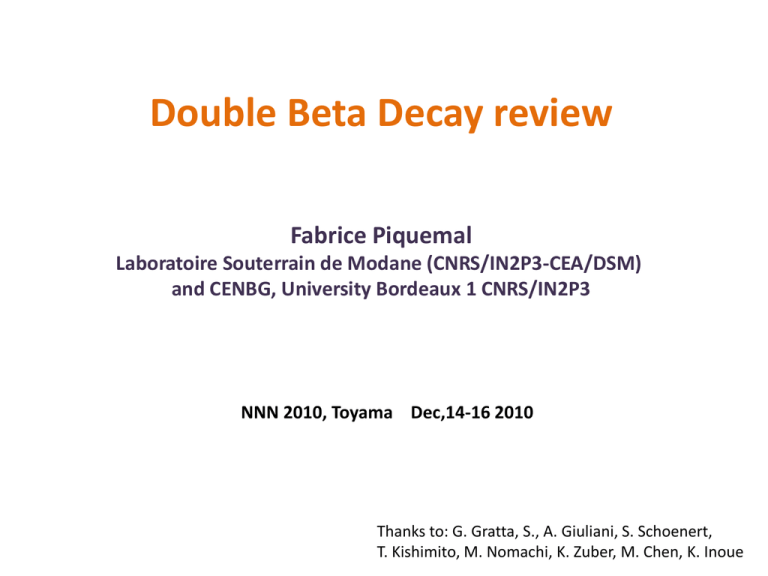
Double Beta Decay review Fabrice Piquemal Laboratoire Souterrain de Modane (CNRS/IN2P3-CEA/DSM) and CENBG, University Bordeaux 1 CNRS/IN2P3 NNN 2010, Toyama Dec,14-16 2010 Thanks to: G. Gratta, S., A. Giuliani, S. Schoenert, T. Kishimito, M. Nomachi, K. Zuber, M. Chen, K. Inoue Double Beta decay: physics case (A,Z) (A,Z+2) + 2e- - Leptonic number violation - Nature of neutrino : Dirac (n n) or Majorana (n =n) - Absolute neutrino mass and neutrino mass hierarchy - Right-handed current interaction - CP violation in leptonic sector - Search of Supersymmetry and new particles Double Beta decays Single beta decay forbidden (energy) or strongly suppressed by large angular momentum change bb Decay to ground state or excited states e- bb(0n) bb(2n) e- e- e- n n 2nd order process of weak interaction Already observed for several nuclei DL =2 bb(0n) Majorana neutrino (n=n) Neutrinoless Double Beta decay (A,Z) (A,Z+2) + 2 e- Discovery implies DL=2 and Majorana neutrino Phase space factor -1 Nuclear matrix element 5 T1/2= F(Qbb,Z) |M|2 <mn>2 Effective mass: <mn>= m1|Ue1|2 + m2|Ue2|2.eia1 + m3|Ue3|2.eia2 |Uei|: mixing matrix element a1 et a2: Majorana phase Process Light neutrino exchange (V+A) current Majoron emission SUSY parameters <mn> <mn>,<l>,<h> <gM> l’111,l’113l’131,….. bb(0n) observables bb(2n) bb(0n) Electron energy sum Mass mechanism RHC Angular distribution From G. Gratta Mass mechanism RHC Ee1 – Ee2 distribution 150Nd distribution s arxiv: 1005.1241v1 [hep-ex] Why so many experiments or projects ? Experiments Isotopes Techniques Main caracteristics NEMO3 100Mo,82Se Tracking + calorimeter Bckg rejection, isotope choice SuperNEMO 82Se, 150Nd Tracking + calorimeter Bckg rejection, isotope choice Cuoricino 130Te Bolometers Energy resolution, efficiency CUORE 130Te Bolometers Energy resolution, efficiency GERDA 76Ge Ge diodes Energy resolution, eficiency Majorana 76Ge Ge diodes Energy resolution, efficiency ZnCdTe semi-conductors Energy resolution, efficiency COBRA 130Te, 116Cd EXO 136Xe TPC ionisation + scintillation Mass, efficiency, final state signature MOON 100Mo Tracking + calorimeter Compactness, Bckg rejection CANDLES 48Ca CaF2 scintillating crystals Efficiency, Background SNO++ 150Nd Nd loaded liquid scintillator Mass, efficiency XMASS 136Xe Liquid Xe Mass, efficiency CARVEL 48Ca CaWO4 scintillating crystals Mass, efficiency Yangyang 124Sn Sn loaded liquid scintillator Mass, efficiency DCBA 150Nd Gazeous TPC Bckg rejection, efficiency Double beta decay isotopes Isotope Qbb (MeV) Abondance isotopique (%) 48Ca 4.271 0.187 2.44 Laser ? 76Ge 2.040 7.8 0.24 Centrifugation 82Se 2.995 9.2 1.08 Centrifugation 96Zr 3.350 2.8 2.24 Laser ? 100Mo 3.034 9.6 1.75 Centrifugation 116Cd 2.802 7.5 1.89 Centrifugation 130Te 2.528 33.8 1.70 Centrifugation 136Xe 2.479 8.9 1.81 Centrifugation 150Nd 3.367 5.6 8.00 Laser ? Centrifugation ? G0n(an-1) x 1025 Enrichment method Nuclear Matrix Element arXiv:1008.5260v2 : Tomás R. Rodríguez, G. Martinez-Pinedo Background components 2.614 MeV Highest gamma-ray from natural radioactivity 76Ge 2 76Xe 130Te 100Mo 150Nd 82Se 96Zr 3 48Ca 4 Natural radioactivity (40K, 60Co,234mPa, external 214Bi and 208Tl…) 214Bi and Radon, 208Tl (2.6 MeV g line) and Thoron, g from (n,g) reaction and muons bremstrahlung + bb(2n) for tracko-calo or calorimeter with modest energy resolution + for pure calorimeter Surface or bulk contamination in a emitters, cosmogenic production 5 Qbb MeV Experimental sensitivity T 0n 1/ 2 e (y) A M: masse (g) e : efficiency KC.L.: Confidence level N: Avogadro number Calorimeter Semi-conductors Bolometers Source = detector M .t NBckg . DE t: time (y) NBckg: Background events (keV-1.g-1.y-1) DE: energy resolution (keV) Tracko-calo Calorimeter (Loaded) Scintillator Source detector Source = detector b b b b e, DE <mn > M1/4 e, M Xe TPC Source = detector b b b NBckg, isotope choice b e,M, (NBckg) Calorimeter vs Tracko-calo Tracko-calo Calorimeter High energy resolution Modest background rejection High background rejection Modest energy resolution bb(0n) bb(0n) keV bb(0n) bb(0n) keV MeV Why so many experiments or projects ? What is the most favorable isotope and the best technique ? Phase space factor: 48Ca, 150Nd, 96Zr Nuclear matrix element not yet reliable predictions 48Ca, 150Nd, 96Zr, 100Mo, 82Se, 116Cd Backgrounds > 2,6 MeV > 3.2 MeV (radon) 48Ca, 150Nd, 96Zr Enrichment: 130Te (Natural isotopic abundance 34%) 136Xe (gaz, easy to enrich) Best techniques : Bolometers, Ge diodes: energy resolution 130Te (82Se, 116Cd), 76Ge Tracko-calo : background rejection 82Se, (48Ca, 150Nd) TPC Xe: background rejection if tagging of Ba 136Xe Large liquid scintillator: mass of isotopes 136Xe, 150Nd A problem to understand: the background at ~100 kg (related to istopes and techniques) Effective neutrino mass and q13 Isotope mass ~ 10 kg Required background level 2011 ~ 1000 kg |mee| ~ 100 kg 2015 100 – 1000 cts/yr/ton 1 – 10 cts/yr/ton 0.1 – 1 cts/yr/ton Heidelberg-Moscow (2001) ~11 kg of enriched Ge bb(0n) ? S T Petcov 2009 J. Phys.: Conf. Ser. 173 012025 This experimental review will be focused on the last results of 10 kg and 100 kg experiments bb(0n) : experiments and projects NEMO3/SuperNEMO (82Se, 150Nd, 48Ca) NEXT (136Xe) SNO++ (150Nd) DCBA (150Nd) EXO (136Xe) Majorana (76Ge) EXO gaz (136Xe) Cuoricino/CUORE (130Te) GERDA (76Ge) COBRA (116Cd) Calorimeter Source = detector CANDLES (48Ca) KamLAND-ZEN (136Xe MOON (100Mo) Tracko-calo Source detector b b b b bb(0n): Present situation Ge diode detectors Heidelberg-Moscow (2001) ~11 kg of enriched 76Ge (86%) 35.5 k.yr IGEX (2002) ~ 8.4 kg of enriched 76Ge (86%) 8.9 kg.yr without PSA 4.6 kg.y with PSA 0.06 cts/keV/kg/yr T 1/2 >1.9 1025 yr (90% CL) T 1/2 >1.57 1025 yr (90% CL) <mn> <0.35-1.05 eV (90% CL) <mn> <0.33-1.31 eV (90% CL) Eur. Phys. J., A 12 (2001) 147 Phys. Rev. D65 (2002) 092007 Cuoricino Bolomètres: CUORICINO Bolometers of TeO2 Heat sink Thermometer Double beta decay Crystal absorber Stopped in 2008 DE/E ~ 8 keV at 2 527 keV Located in Gran Sasso Laboratory (Italy) Bolomètres: CUORICINO Cuoricino results CUORE CUORE (Italy, USA,Spain) 750 kg of TeO2 203 kg of 130 Te Array of 988 TeO2 5x5x5 cm3 crystals Improvement of surface event rejection Goal :Nbckg=0.01 cts.keV-1.kg-1.yr-1 (Factor 20 compared to Cuoricino) Nbckg=0.01 cts.keV-1.kg-1.yr-1 LUCIFER: R&D on scintillating bolometers like 82Se 116CdWO 4 T½ > 2.1 1026 yr Test of 1 tower of CUORE in Cuoricino in 2011 Expected sensitivity <mn> < 0.03 – 0.17 eV Data taking foreseen in 2013 NEMO 3 Tracko-calo detector Drift chamber (6000 cells) Plastic scintillator + PMT (2000) 10 kg of isotopes DE/E (FWHM) : 8 % @ 3 MeV Located in Modane Underground Lab (France) Bckg: 0.025 cts/keV/kg/yr Multi-source detector E1 bb sources (thickness 0 mg/cm2) e- Vertex bb(2n) eBckg E1+E2= 2088 keV Dt= 0.22 ns (Dvertex) = 2.1 mm bb events E2 82Se (0,93 kg) NEMO 3 Results 100Mo, 23.4 kg.yr 620 000 events Bosonic fraction of neutrino wave function Sin c < 0.6 NEMO 3 Results NEMO 3 Results From NEMO 3 to SuperNEMO T1/2 (bb0n) > ln 2 NA A M e Tobs N90 SuperNEMO NEMO-3 100Mo isotope 7 kg isotope mass M 15 % efficiency e , 82Se 150Nd or 48Ca 100 kg ~ 30 % < 20 mBq/kg 214Bi: < 300 mBq/kg internal contaminations 208Tl and 214Bi in the bb foil < 2 mBq/kg if 82Se: 214Bi < 10 mBq/kg 8% @ 3MeV energy resolution (FWHM) 4% @ 3 MeV 208Tl: T1/2(bb0n) > 2 x 1024 y <mn> < 0.3 – 1.3 eV 208Tl T1/2(bb0n) > 1026 y <mn> < 50 – 110 meV SuperNEMO conceptual design 20 modules for 100 kg Source (40 mg/cm2) 12m2 Tracking (~2-3000 Geiger cells). Calorimeter (500 channels) Total:~ 40 000 – 60 000 geiger cells channels ~ 10 000 PMT 1m 5m Top view SuperNEMO DE/E < 4% (FWHM) @ Qbb demonstrated Commissioning of wiring robot (< 8% @ 1 MeV) FWHM = 7,1 % (7,6% before energy loss correction) SuperNEMO phase I : 2011 – 2014 Contruction demontrator module with 7 kg of 82Se (1 kg of 48Ca ?) Commissing @LSM 2013 Sensitivity in 1 year: T1/2 < 5 1024 y <mn> < 0.2 – 0.6 eV SuperNEMO phase II : 2014 – 2019 100 kg of 82Se (or 150Nd,or 48Ca) T1/2 > 1026 y <mn> < 0.05 – 0.14 eV SuperNEMO @ LSM extension Ge detector improvements Strategies: Ge detectors in liquid nitrogen to remove materials Active shielding and segmentation of detectors to reject gamma-rays crystal anti-coincidence detector Detector segmentation segments e- g pulse shape analysis R&D: liquid argon anti-coincidence Liquid argon e- scintillation GERDA Removal of matter Use of liquid nitrogen or argon for active shielding Segmented detectors in futur Improvement of Pulse Shape Analysis PHASE I: 17.9 kg of enriched 76Ge (from HM and IGEX) In 1 year of data if B=10-2 cts/keV/kg/yr (check of Klapdor’s claim) Start 2011 at Gran Sasso T1/2 > 3 1025 yr <mn> < 0.25 eV PHASE II: 40 kg of enriched 76Ge (20 kg segmented) 2012 if B=10-3 cts/keV/kg/an T1/2 > 2 1026 yr in 3 years of data <mn> < 0.1 eV GERDA • Nov/Dec.’09: Liquid argon fill • Jan ’10: Commissioning of cryogenic system • Apr/Mai ’10: emergency drainage tests of water tank • Apr/Mai ’10: Installation clock • May ’10: 1st deployment of FE&detector mock-up • June ‘10: Commissioning with natGe detector string • Soon: start Phase I physics data taking Majorana (USA, Russia, Japan) Ge diodes Very pure material (Electroformed copper) Segmentation PSD improvement R&D phase 30-60 kg of 86% enriched 76Ge crystals Some of the crystals segmented Bckg goal ~ 1 count/ROI/t-yr (after analysis cuts) 30 kg of enriched Ge, running 3 yr. Data taking scheduled for 2011 T1/2 > 1. 1026 yr <mn> < 0.14 eV (could confirm or refute Klapdor’s claim) Collaboration with Gerda for 1 ton detector EXO - 200 (USA, Canada, Switzerland, Russia) Liquid Xe TPC Ionization + scintillation DE/E (FWHM)= 3.3 % @Qbb Possibility of Baryum ion tagging by Laser florescence (136Xe 136Ba++ + 2 e R&D in progress Gazeous TPC R&D 200 kg of 136Xe, no Ba ion tagging Installation in WIPP underground lab Possibility to measure bb(2n) EXO-200 full of natural Xe - Tuning on all systems - Engineering runs - Physics mode as soon as possible SNO++ Scintillator loaded with Nd. 500 kg of 150Nd 1 year <mn> = 150 meV Test of light attenuation Study of Nd purification (factor 1000 per pass in Th and Ra) 56 kg of 150Nd (0,1 % of natural Nd) 500 kg of 150Nd 4yr <mn> ~ 0.03 eV only internal Th and 8B solar neutrino backgrounds are important 4 yr of data <mn> ~0.08 eV KamLAND-Zen CANDLES (Japan) Pure CaF2 crystals Liquid Scintillator (Veto Counter) Wave length shifter in LS PSD to reject g and a CaF2(Pure) Buffer Oil Large PMT CANDLES III 103 cm3 × 96 crystals 305 kg Data taking in 2011 @ Kamioka Expected BG: 0.14 event/yr (30 µBq/kg) <mn> ~0.5 eV CANDLES IV : 3 tons of CaF2 (3 mBq/kg) 6 yr <mn> ~0.1 eV DCBA Drift Chamber beta-ray Analyser Prototype with 207Bi : 10% (FWHM) energy resolution X position s= 0.5 mm Y position s= 0.02 mm X position s= 6 mm COBRA (UK, Germany, Italy, poland, Slovaquia, Finland, USA) Array of 1cm3 CdZnTe detectors Cd-113 beta decay with half-life of about 1016 yrs 4x4x4 detector array = 0.42 kg CdZnTe Installed at LNGS Test of coincidence rejection Measure of 113Cd Sensitivities 2013 - 2018 Technique EXO GERDA Location Liquid Xe 136Xe WIPP (USA) Diode Ge 76Ge Gan sasso (Italy) CUORE-0 CUORE SN module0 Mass kg start Cts/keV/kg/yr T1/2(0n) <mee> meV 200 2011 0.002 6.4 1025 < 109 – 135 18 2011 0.01 3. 1025 < 250– 380 40 2012 0.001 3. 1026 < 80 - 120 0.12 8. 1025 <100 - 200 2.1 1026 6.5 1026 < 41 -82 < 23- 47 < 200 –600 13 Bolometers 130Te Gan sasso (Italy) Tracko-calo Modane 82Se, 150Nd (France) SuperNEMO 2011 Bckg 200 2013 0.01 0.001 7 2013 0.0001 6. 1024 100 2015 0.0001 1026 SNO+ Liq. Scint. 150Nd SNOLAB (Canada) 44 2012 KamLAND Liq. Scinti 136Xe Kamioka (Japan) 400 2011 (2yr) (1yr) < 53 – 140 < 100 < ~ 60 (2 yr) Summary Present 10 kg experiment reach a sensitivity <mn> < 0.3 – 1 eV Background ~100 – 1000 cts/ton/yr 1OO kg experiments will reach a sensitivity on <mn> < ~50 meV in the next 5 yr Background ~ 1 – 10 cts/ton/yr (Remark: to win a factor 10 on bckg it takes 5 – 10 yrs) Step by step approach: GERDA, MAJORANA, CUORE, SuperNEMO Agressive approach (no 10 kg prototype): EXO, SNO++, KamLAN-Zen, NEXT Possibility to enrich 150Nd, 96Zr or 48Ca in the futur ? 100 kg experiments essential to validate technique and background for 1 ton experiments 100 kg experiments Step by step approach GERDA Ge diode in LAr CUORE 130Te bolometers Gran Sasso laboratory Gran Sasso laboratory 2010: 18 kg of 76Ge (HM and IGEX crystals) CUORE-0 39 kg of natTe 13 kg of 130Te Data taking 2011 1st results 2011 + Energy resolution 2012: 40 kg of 76Ge MAJORANA Ge segmented Diode DUSEL laboratory 2011: 20 kg of natGe 2013 ? : 30 kg of 76Ge + Energy resolution + Energy resolution + Natural Te CUORE 200 kg Data taking 2013 (scintillating bolometres ?) SuperNEMO tracko-calo Modane laboratory Module-0 7 kg of 82Se (150Nd) Data taking 2013 + Background rejection 20 Module 100 kg Data taking 2015 + Multi-isotopes 100 kg experiments Agressive approach (no 10 kg prototype) EXO liquid Xenon WIPPL laboratory 2010: 200 kg of 136Xe Results 2013 Ba tagging R&D + Large mass + Possibility to tag daughter nucleus KamLAND-Zen Xe + liq. scintillator SNO++ Nd salt + liquid scintillator SNOLAB laboratory 2010: 740 kg of natNd (44 kg of 150Nd) Dissolved in scintillator + Large mass + low background detector NEXT Xe high pressure TPC Canfranc laboratory Kamioka laboratory 2011: 1 kg of 136Xe 2011: 400 kg of 136Xe Dissolved in liq. scintillator + Large mass 2013 : 100 kg + Background rejection bb(0n) signal ? HM claim 2006: Improvement of PSA (6s) 2004 (4s) T1/2 = (0.69 – 4.18) 1025 <mn> = 0.28-0.58 (90%) T1/2 = 2.23 +0.44 1025 yr -0.31 <mn> = 0.32 ± 0.03 eV Nuclear Matrix Element arXiv:1008.5260v2 : Tomás R. Rodríguez, G. Martinez-Pinedo From F. Simkovic (neutrino 2010)



